Night Shift Worker Survival Kit: Essential Products For Overnight Shifts
Night Shift Worker Survival Kit: Essential Products for Overnight Shifts Working the night shift comes with unique challenges that most day workers never experience. From fighting your body’s natural sleep rhythm to dealing with limited food options at 3 AM, night shifts require special preparation to maintain your health, energy, and sanity. But having the…
![Photo of [object Object] in undefined](https://nightowling.com/wp-content/uploads/2025/10/image-212.png)
Night Shift Worker Survival Kit: Essential Products for Overnight Shifts
Working the night shift comes with unique challenges that most day workers never experience. From fighting your body’s natural sleep rhythm to dealing with limited food options at 3 AM, night shifts require special preparation to maintain your health, energy, and sanity.
But having the right tools can make all the difference between merely surviving and actually thriving on the night shift.
I’ve spent years helping night shift workers develop strategies to protect their wellbeing, and one consistent finding stands out: those who invest in the right supportive products report better sleep, higher energy levels, and improved overall satisfaction with their unconventional schedule.
In this comprehensive guide, I’ll walk you through the essential items every night worker should consider adding to their survival kit. These aren’t just random recommendations—they’re evidence-based solutions to the specific challenges that night shift work presents.
Whether you’re new to the night shift or a seasoned veteran looking to optimize your routine, this guide will help you build a personalized survival kit tailored to your needs.
Jump to a specific section in this article ↓↓
- Why night shift workers need specialized equipment
- Sleep aids that actually work for daytime sleep
- Light management tools for better sleep and alertness
- Nutrition and hydration essentials for overnight shifts
- Energy management products that aren’t just caffeine
- Temperature regulation for better daytime sleep
- Commute safety items for drowsy driving prevention
- Digital tools and apps for night shift workers
- How NightOwling can support your night shift journey
- All of the FAQs in this article: Night Shift Worker Survival Kit

Why night shift workers need specialized equipment
Working nights isn’t just a schedule flip—it’s a complete lifestyle adjustment that requires specific tools to manage effectively.
The unique challenges of night shift work
Night shift work forces you to operate against your body’s natural circadian rhythm. This misalignment affects virtually every system in your body, from hormone production to digestion to cognitive function.
The primary challenges that require specialized solutions include:
Sleeping during daylight hours when your body naturally wants to be awake and when environmental disruptions (light, noise, temperature) are at their peak.
Staying alert overnight when your body’s core temperature drops and melatonin production increases, naturally promoting sleepiness.
Maintaining proper nutrition when your metabolism is naturally slower and food options are limited during overnight hours.
Managing light exposure appropriately to help shift your circadian rhythm without completely disrupting it.
Preventing social isolation that can result from an inverted schedule relative to friends and family.
Standard solutions designed for day workers often fall short when applied to these unique night shift challenges. That’s why targeted products designed specifically for circadian disruption can be game-changers for night workers.
The ROI of investing in night shift equipment
While building a comprehensive night shift kit requires some upfront investment, the returns in terms of health, safety, and quality of life are substantial.
Consider the cost of poor sleep: decreased cognitive function, increased accident risk, compromised immune function, and higher rates of chronic conditions like diabetes and heart disease. The right tools to improve sleep quality and manage circadian disruption can help mitigate these risks.
Similarly, products that help you maintain proper nutrition and hydration during overnight hours can prevent the metabolic issues commonly associated with night work.
The key is to view these items not as luxuries but as necessary investments in your long-term health and wellbeing. For personalized guidance on which investments might make the biggest difference in your specific situation, NightOwling’s guided journeys can provide tailored recommendations.
↑↑ Back to the list at the top ↑↑
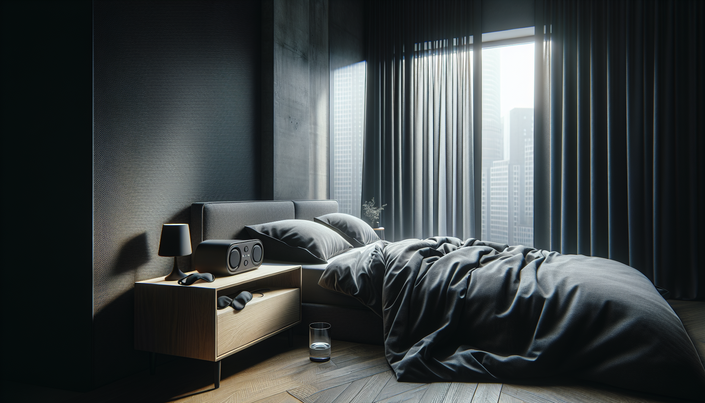
Sleep aids that actually work for daytime sleep
Quality sleep is the foundation of night shift survival, yet achieving restful sleep during daylight hours presents unique challenges. These tools can make a significant difference.
Blackout solutions for true darkness
Melatonin production—essential for quality sleep—is suppressed by even minimal light exposure. Creating complete darkness in your sleep environment is critical.
Blackout curtains are the first line of defense against daylight. Look for curtains specifically labeled as “100% blackout” or “light-blocking” with a tight weave and multiple layers. The best options include a thermal layer that not only blocks light but also helps with temperature regulation and sound dampening.
For even more complete darkness, consider window films that adhere directly to the glass. These can be used alone or in combination with curtains for maximum light-blocking efficiency.
Sleep masks provide portable light-blocking and are especially useful for night workers who travel or sleep in multiple locations. Look for contoured designs that don’t put pressure on your eyes, adjustable straps, and breathable materials. Some advanced models include cooling gel inserts or weighted elements for additional relaxation benefits.
Sound management for uninterrupted rest
Daytime sleep means contending with significantly more environmental noise. Effective sound management requires a multi-layered approach.
White noise machines create a consistent sound backdrop that masks unpredictable noises like traffic, construction, or household activities. Models with multiple sound options (white, pink, and brown noise) allow you to find the most effective masking frequency for your specific environment.
Earplugs come in various materials and noise reduction ratings (NRR). Foam earplugs are inexpensive but may not be comfortable for side sleepers. Silicone options mold to your ear shape and provide excellent noise blocking, while wax earplugs offer superior sound isolation and comfort.
For those who find earplugs uncomfortable, sleep headphones embedded in soft headbands can be an excellent alternative. These allow you to listen to white noise, meditation, or calming sounds without disturbing others.
Temperature regulation tools
Your body temperature naturally drops during sleep, and a cool environment (60-67°F/15-19°C) supports this process. However, daytime temperatures often work against this need.
Cooling mattress toppers made with gel-infused memory foam or natural materials like bamboo can significantly reduce sleep surface temperature. Some advanced options even allow for precise temperature control.
Bedroom air conditioners or fans are essential for many night workers, especially during summer months. If a dedicated AC unit isn’t feasible, portable options or strategically placed fans can help maintain airflow and reduce temperature.
Cooling pillows and bedding made from moisture-wicking, breathable fabrics like bamboo, Tencel, or special cooling polyester blends can make a noticeable difference in sleep comfort during warmer daytime hours.
↑↑ Back to the list at the top ↑↑

Light management tools for better sleep and alertness
Light is the most powerful regulator of your circadian rhythm. Strategic light exposure and avoidance can help shift your internal clock to better align with night work.
Blue light blocking glasses
Blue wavelength light has the strongest effect on suppressing melatonin production. Blue light blocking glasses can help protect your sleep hormone production when you’re exposed to light at the “wrong” times.
For night shift workers, two pairs of blue blockers serve different purposes:
Daytime commute glasses (80-90% blue light blocking) should be worn after your shift during the morning commute home to minimize the wake-promoting effects of morning sunlight. These typically have amber or orange-tinted lenses.
Evening screen use glasses (30-60% blue light blocking) can be worn during the early part of your shift when you need to stay alert but still want some protection from the harshest blue light from screens and indoor lighting. These usually have yellow-tinted lenses.
Look for glasses that fit comfortably over prescription eyewear if needed, provide wrap-around coverage to prevent light leakage, and come with a protective case for transportation.
Light therapy devices
Strategic bright light exposure can help shift your circadian rhythm to better align with night work. Light therapy devices provide the intensity and specific wavelengths needed for this purpose.
Light therapy lamps (10,000 lux) used for 20-30 minutes at the beginning of your wake period can increase alertness and help shift your internal clock. Look for models that are portable, adjustable in height and angle, and have multiple brightness settings.
Light therapy glasses offer a more portable alternative. These wearable devices direct light downward into the eyes while allowing normal vision. They’re particularly useful for night workers who need to remain mobile during their pre-shift preparation.
Dawn/dusk simulators that gradually change light intensity to mimic sunrise and sunset can be programmed to align with your sleep-wake schedule, providing gentle wake-up light when you need to start your day and gradually dimming to support natural melatonin production before sleep.
Smart lighting systems
Creating the right lighting environment throughout your home can support your shifted schedule.
Programmable smart bulbs that adjust color temperature and brightness based on time of day can automatically create alertness-promoting environments when you need to be awake and sleep-promoting environments when you need to rest.
Motion-activated night lights with red wavelength light (which has minimal impact on melatonin) allow safe navigation during sleep hours without disrupting your sleep cycle.
Light-blocking technology for electronics includes screen filters and apps that reduce blue light emission from devices. While many devices now have built-in night modes, additional filters can provide more complete protection.
For personalized guidance on optimizing your light exposure throughout your 24-hour cycle, check out our tools NightOwling’s light management resources.
↑↑ Back to the list at the top ↑↑
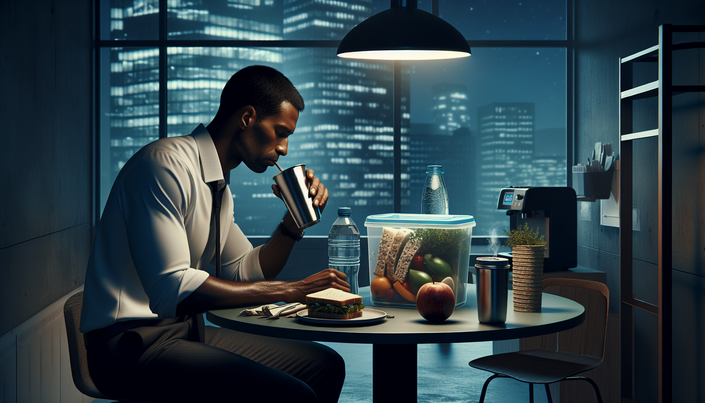
Nutrition and hydration essentials for overnight shifts
Maintaining proper nutrition and hydration during night shifts is challenging but crucial. The right tools can help you stay nourished and hydrated despite limited options.
Meal prep and storage solutions
Preparing and storing nutritious meals for overnight consumption requires specialized equipment.
Insulated food containers that maintain temperature for 8+ hours allow you to bring hot or cold homemade meals to work. Look for vacuum-insulated stainless steel options with wide mouths for easy eating and cleaning.
Compartmentalized bento-style containers help with portion control and meal variety. Models with leak-proof seals and microwave-safe materials offer maximum versatility.
Electric lunch boxes that plug into wall outlets or car adaptors can heat meals at work without access to a microwave. Some models even include multiple compartments to heat different foods simultaneously.
Strategic snack options
Healthy snacking during night shifts helps maintain energy levels and prevent the metabolic disruption common in night workers.
Protein-rich, shelf-stable options like jerky, protein bars, nuts, and seeds provide sustained energy without refrigeration. Look for minimally processed options without added sugars or artificial ingredients.
Portable fruit solutions such as freeze-dried fruits or single-serve unsweetened applesauce provide essential nutrients and natural sweetness without the perishability of fresh produce.
Electrolyte supplements in tablet, powder, or ready-to-drink form can help maintain proper hydration and mineral balance, which is particularly important during overnight hours when dehydration is common but often goes unnoticed.
Hydration management
Proper hydration timing and tracking are essential for night shift workers.
Large insulated water bottles (24-40oz) with time markers encourage consistent hydration throughout your shift. Models with flip tops or straws facilitate one-handed drinking without disrupting your work.
Electrolyte drink mixes without added sugars can improve fluid absorption and replace minerals lost through sweat, especially in physically demanding night jobs.
Smart water bottles that track intake and send reminders can be particularly helpful during the 2-5am period when thirst perception is naturally diminished but hydration remains important.
↑↑ Back to the list at the top ↑↑
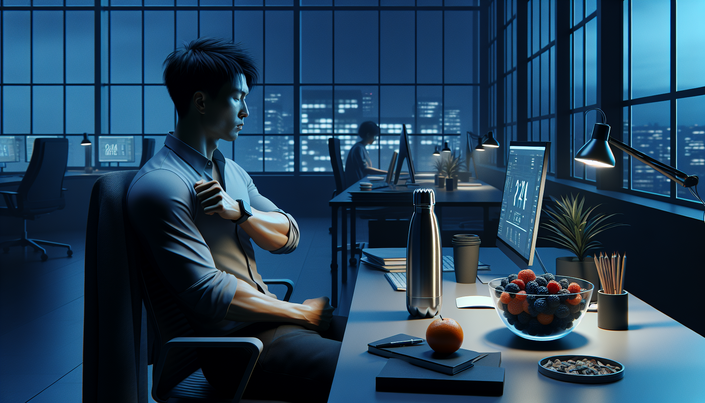
Energy management products that aren’t just caffeine
Maintaining alertness during night shifts requires more sophisticated approaches than simply consuming caffeine. These tools help support natural energy and combat fatigue more effectively.
Strategic caffeine alternatives and supplements
While caffeine remains useful for many night workers, alternatives and strategic delivery methods can provide more stable energy without disrupting subsequent sleep.
L-theanine supplements combined with caffeine provide smoother, longer-lasting alertness without the jitters or crash associated with caffeine alone. This amino acid naturally occurs in green tea and promotes calm focus.
B-vitamin complexes support energy metabolism at the cellular level. Look for methylated forms of B vitamins for better absorption and effectiveness.
Adaptogenic herbs like rhodiola, ashwagandha, and holy basil help the body manage stress and maintain energy during periods of circadian disruption. These can be taken as supplements or consumed as teas.
Physical alertness tools
Physical stimulation can combat fatigue when mental alertness wanes during the circadian low point.
Acupressure rings and massage balls stimulate pressure points to increase alertness. Simply rolling a spiky massage ball in your hands or applying an acupressure ring for 1-2 minutes can provide a surprising boost in wakefulness.
Cooling products like peppermint-infused neck wraps or cooling towels can counteract the drowsiness associated with the natural drop in body temperature during overnight hours.
Portable resistance bands or grip strengtheners kept at your workstation allow for quick physical activity to increase circulation and alertness during slow periods.
Cognitive alertness aids
Mental engagement is crucial for maintaining focus and preventing microsleeps during night shifts.
Brain training apps specifically designed to boost alertness through short cognitive challenges can be particularly effective during the 2-5am circadian low point.
Puzzle books or mind games kept at your workstation provide offline mental stimulation during breaks or slow periods.
Audiobooks and engaging podcasts can maintain mental alertness during repetitive tasks or commutes. Educational content is particularly effective at promoting wakefulness.
For personalized energy management strategies based on your specific work pattern and preferences, visit NightOwling for customized recommendations.
↑↑ Back to the list at the top ↑↑
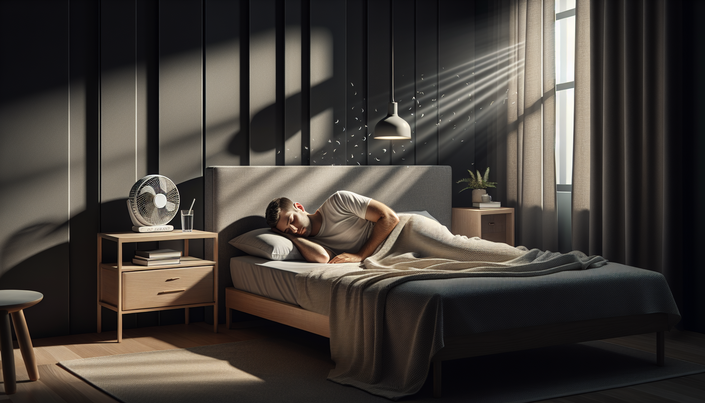
Temperature regulation for better daytime sleep
Controlling your sleep environment temperature is crucial for night shift workers, as daytime temperatures are naturally higher and can interfere with sleep quality.
Cooling solutions for sleep spaces
Creating and maintaining a cool sleep environment during daylight hours often requires specialized equipment.
Blackout curtains with thermal properties not only block light but also insulate against heat, keeping your bedroom cooler during hot days. Look for options labeled with thermal or energy-efficient properties.
Portable air conditioners or cooling fans provide targeted cooling in your sleep space without necessarily cooling the entire home. Models with programmable timers and low noise ratings are ideal for sleep environments.
Cooling mattress pads with water circulation systems allow precise temperature control of your sleep surface. While more expensive than passive cooling options, these systems provide customizable cooling that can make a significant difference in sleep quality during hot days.
Personal cooling for sleep onset
Lowering your core body temperature can help signal sleep readiness and improve sleep onset.
Cooling pillows and bed linens made with phase-change materials maintain a consistently cool sleep surface. These materials absorb and dissipate body heat, keeping the sleep surface cool to the touch.
Personal cooling wraps for the neck, wrists, or forehead target pulse points where blood vessels run close to the skin, effectively cooling your core temperature.
Cooling weighted blankets combine the anxiety-reducing pressure of traditional weighted blankets with cooling technologies like glass beads and breathable fabrics, providing comfort without overheating.
For guidance on creating the optimal temperature environment for your specific living situation, check out NightOwling’s sleep environment assessment tools.
↑↑ Back to the list at the top ↑↑
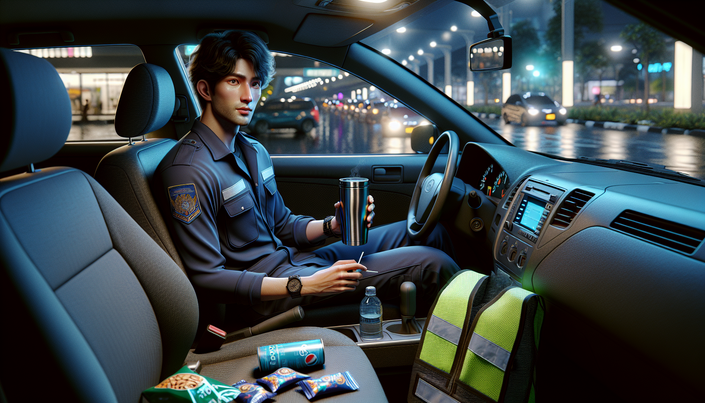
Commute safety items for drowsy driving prevention
The commute home after a night shift is statistically one of the most dangerous times for night workers due to drowsiness and impaired reaction time.
Alertness monitors and aids
Technology can help detect and combat dangerous drowsiness during post-shift commutes.
Drowsiness detection apps use smartphone cameras to monitor eye movements and blink patterns, alerting you when signs of dangerous drowsiness appear. Some advanced versions can be paired with wearable devices for more accurate monitoring.
In-car alert systems from simple vibration alarms to sophisticated devices that monitor steering patterns or require periodic response can help prevent microsleeps during driving.
Cooling elements like AC directed at your face or cooling neck wraps can increase alertness during your commute by counteracting the natural drop in body temperature associated with sleepiness.
Pre-commute preparation tools
Proactive preparation before driving home can significantly improve commute safety.
Bright light therapy devices used for 10-15 minutes before driving can temporarily boost alertness for safer commuting. Portable options that plug into car adapters are particularly convenient for night workers.
Quick-energy snacks with both protein and complex carbohydrates consumed 15-20 minutes before driving provide fuel for the brain without causing energy crashes. Options like nuts with dried fruit or plain Greek yogurt with granola are ideal.
Hydration reminder systems help ensure you’re properly hydrated before driving, as even mild dehydration can impair cognitive function and reaction time.
For comprehensive strategies to manage commute safety as a night shift worker, explore NightOwling’s guided resources designed to protect your wellbeing.
↑↑ Back to the list at the top ↑↑

Digital tools and apps for night shift workers
Technology can be a powerful ally in managing the unique challenges of night shift work. These digital solutions address specific night shift needs.
Sleep tracking and improvement
Understanding and optimizing your sleep patterns is particularly important for night workers.
Sleep cycle apps specifically designed for irregular sleep schedules (unlike standard apps that assume night sleep) can track quality and duration of daytime sleep, providing insights into your sleep patterns and environment.
Guided sleep meditation apps with content specifically for daytime sleep and circadian disruption can help quiet the mind and prepare for sleep despite environmental challenges.
Smart alarm systems that wake you during lighter sleep phases within a designated window can reduce sleep inertia and grogginess, making the transition to wakefulness smoother.
Scheduling and social coordination
Managing a schedule that differs from most of society requires specialized tools.
Shift work calendar apps that easily display your schedule in relation to standard calendar events make social planning much more manageable. Look for options that allow sharing with family members.
Reminder systems for sleep times and wake times help maintain consistency in your schedule, even on days off when social pressure might push you toward disrupting your rhythm.
Meal timing apps that align with night shift schedules rather than conventional mealtimes can help optimize nutrition and digestion despite an unconventional schedule.
Learning and community
Educational resources and connection with others sharing similar challenges can be invaluable.
Night worker forums and communities provide social connection and practical advice from others who understand your lifestyle. These digital communities can reduce the isolation many night workers experience.
Circadian education apps that teach principles of light management, sleep hygiene, and biological rhythms help you make informed decisions about managing your health on the night shift.
Shift work research updates through dedicated apps or newsletters keep you informed about the latest findings and recommendations relevant to night shift health.
For curated recommendations of digital tools specifically tested with night shift workers, visit NightOwling’s resource center.
↑↑ Back to the list at the top ↑↑
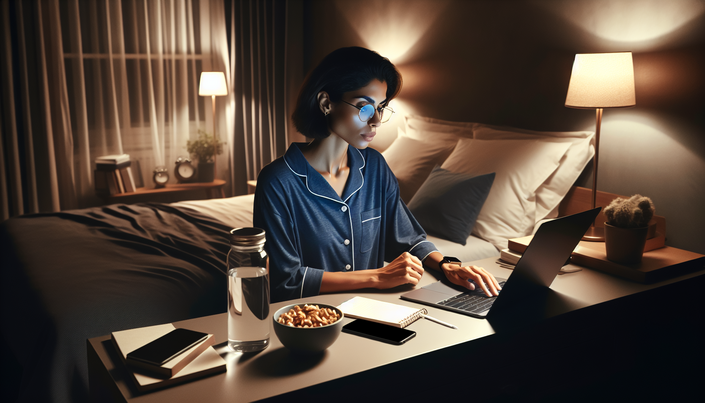
How NightOwling can support your night shift journey
Managing night shift work doesn’t have to be a solo endeavor. NightOwling was created specifically to support night shift workers through evidence-based strategies and community connection.
Personalized recommendations and assessments
Night shift challenges vary based on your specific work pattern, chronotype, living situation, and health status. NightOwling provides:
Customized product recommendations based on your particular challenges, preferences, and budget. Rather than a one-size-fits-all approach, these recommendations address your unique circumstances.
Sleep environment assessments that identify specific improvements for your sleeping space, whether you live alone or share space with family members.
Shift adaptation plans tailored to your specific schedule, helping you optimize light exposure, sleep timing, and nutrition for your particular work pattern.
Expert-developed resources and tools
NightOwling’s resources are developed by specialists in sleep medicine, chronobiology, nutrition, and occupational health:
Video tutorials demonstrating optimal use of night shift tools and products ensure you get the maximum benefit from your investments.
Printable guides and checklists help you implement comprehensive strategies for managing light, sleep, nutrition, and social connections.
Research-based product reviews evaluate items specifically for their effectiveness in addressing night shift challenges, not just general quality.
Ongoing support and community
Night shift work is a journey that evolves over time, and ongoing support makes a significant difference:
Regular strategy updates based on the latest research in circadian science and occupational health keep your approach current and effective.
Access to night shift specialists who understand the unique challenges of your lifestyle provides personalized guidance when needed.
Connection with fellow night workers reduces isolation and provides practical peer support from those who truly understand your experiences.
By leveraging these specialized resources, you can develop a comprehensive approach to night shift work that supports your health, performance, and quality of life.
↑↑ Back to the list at the top ↑↑
![Photo of [object Object] in undefined](https://nightowling.com/wp-content/uploads/2025/10/image-223.png)
All of the FAQs in this article: Night Shift Worker Survival Kit
What are the most essential items for a night shift worker?
The highest-priority items are blackout curtains or a sleep mask for daytime sleep, blue-light blocking glasses for the morning commute home, an insulated meal container for healthy overnight nutrition, and a large water bottle with time markers to maintain hydration. These address the fundamental challenges of sleep quality, circadian disruption, nutrition, and hydration that all night workers face.
Are blue light blocking glasses worth the investment for night shift workers?
Yes, blue light blocking glasses are among the most valuable investments for night shift workers. Research shows they can significantly improve daytime sleep quality when worn during the morning commute home by blocking the wavelengths of light that most strongly suppress melatonin production. Look for glasses that block 80-90% of blue light for post-shift use.
What’s the best way to manage caffeine on night shifts?
Rather than relying solely on coffee or energy drinks, consider a tiered approach: use a programmable coffee maker to have fresh coffee ready when you wake, bring a thermos of tea or coffee for the first half of your shift, and keep caffeine tablets for emergency use only. Stop all caffeine consumption at least 5-6 hours before your planned sleep time to prevent interference with daytime sleep.
How do I choose a good blackout curtain?
Look for curtains specifically labeled as “100% blackout” or “light-blocking” with a tight weave and multiple layers including a thermal barrier. Choose curtains that extend beyond the window frame on all sides and consider a curved curtain rod that places the fabric closer to the wall to prevent light leakage. The best options block light, insulate against temperature, and provide some sound dampening.
What’s better for night shift workers: a sleep mask or blackout curtains?
Ideally, use both. Blackout curtains create an overall dark environment but may still allow some light leakage around edges. A sleep mask ensures complete darkness even if your curtains aren’t perfect. For travel or sleeping away from home, a quality sleep mask with contoured eye cups, adjustable straps, and breathable material is essential for maintaining sleep quality wherever you are.
↑↑ Back to the list at the top ↑↑


![Photo of [object Object] in undefined](https://nightowling.com/wp-content/uploads/2025/10/image-249.png)
![Photo of [object Object] in undefined](https://nightowling.com/wp-content/uploads/2025/10/image-200.png)